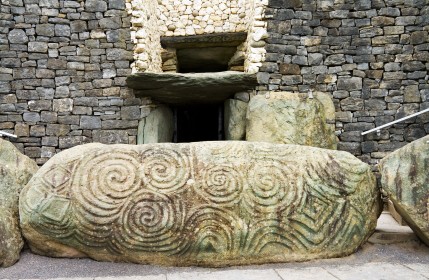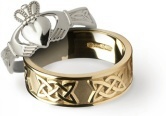Newgrange
Newgrange is found in County Meath, Ireland – just beyond the River Boyne. Built in the Neolithic period, it now stands as one of the best examples of a passage tomb in the British Isles. The entire complex was built circa 3200 B.C., making it around 5000 years old and the carbon-14 dates set it as older than the great pyramid of Giza as well as Stonehenge.

The monument itself consists of a large mound that is approximately 76 meters across and 12 meters high. Within the mound, there is a chambered passage as well as stone circles. There is another circle of standing stones around the perimeter of the Newgrange mound. These stones are thought to have been added during the Bronze Age, which is centuries after the monument was abandoned as a tomb.
There is a significant amount of art throughout the Newgrange monument. The stone at the entrance as well as the Kerbstone 52 found at the back of the monument are considered highly accomplished sculptures. These are some of the best achievements of Neolithic art in Europe. Many of the carvings have intricate circles and spiral designs and some visitors have said that the designs remind them of a stylized face. In the chamber, there is the tri-spiral design – which has now become world-famous.
 |
| Entrance at Newgrange |
Celtic art has been tremendously influenced by the designs found throughout Newgrange. A lot of Celtic jewelry has the tri-spiral design that has been found on many of the large stones and throughout the monument.
There are many examples of abstract rock art carved into the stones. The carvings fit into one of ten different categories. Five fall into curvilinear, which includes arcs, spirals, circles, serpentiforms and dot in circles. The other five are rectilinear, including lozenges, Chevron’s, radials, offsets and parallel lines. There are differences in the style, which shows that these skill levels vary as well as how deeply carved each of the designs are.
The entrance stone, which stands about 3 meters high and weighs about 5 tons has been deemed the most famous stone in all of megalithic art. While archaeologists believe that most of the stones were carved before being put into place, the entrance stone looks as though it was carved prior to the other stones being fit around it.
Speculation about the meaning of the designs has been going on since the discovery of Newgrange. George Coffey believes they are simply decorative while M.J. O’Kelly believes they have some symbolic meaning because many of them were found in areas that would not have been visible. There was an American Irish researcher by the name of Martin Brennan who did a significant amount of research as to how the art relates to astronomy and alignments in the Boyne Valley complex. He also wrote the book “The Stars And The Stones: Ancient Art And Astronomy In Ireland.”
Newgrange is known as a brugh, which is translated as mansion. However, the old Irish word ‘bru’ means womb, so the correct translation may actually be “womb of the moon.” Many archaeologists, artists, and researchers believe that the layout of the passage, chamber, and entrance resembles the female reproductive organs. Additionally, it is aligned with the winter solstice. During this, the light enters the roof box when the sun rises and penetrates the passage. The light will then shine onto the floor of the inner chamber. The beam will only illuminate for 17 minutes – and this is where the majority of the art can be seen at its best.
Newgrange was built during a time when only stone was available for construction materials. No metal has been found as a building material. The only metal that has been found is in the form of Roman coins, which were first found in 1699. No one is entirely sure how these arrived. They were discovered in 1699 by Charles Campbell, when Newgrange is thought to have been rediscovered. It all started because Charles Campbell was looking for stones and when certain stones were removed from the cairn, the entrance to the tomb was revealed.
Approximately 200,000 people visit the monument every year making it the most visited archaeological monument in all of Ireland. It was thought to have been built for an ancient Irish King. Newgrange was supposedly built as a burial ground for Dagda Mor and his three sons, according to mythology. Newgrange is also thought to be where the mythical hero Cuchalainn was conceived by his mother – Dechtine.
Various tales have been told over the years that involve Newgrange. For example, Caer and Aonghus is a tale where two lovers flew here in the form of swans – and this story can be linked to the stars. What makes this story even more interesting is that Newgrange is the winter ground for Whooper Swans. They migrate from Iceland in October and then return home in March.
Newgrange is a popular destination for those who live in Ireland as well as for those who live all around the world. It has a significant amount of meaning for the art world as well as for archaeology. The art is perhaps the most well-known and that is evident in much of the jewelry that is available from Celtic artisans.
Anyone who comes here will find meaning in the stones and the monument in one way or another. Whether you are interested in astrology, archaeology, art or simply history, Newgrange is a monument that will touch you. It is a beautiful place that is nestled along the river bank.
